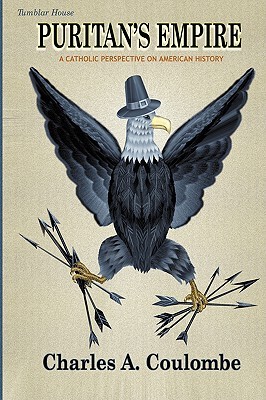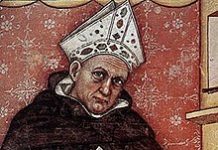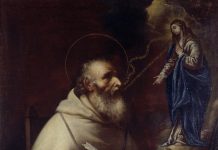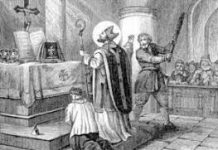“This above all: To thine own self be true.”
–William Shakespeare
Puritan’s Empire by Charles A. Coulombe is a unique tour-de-force of American history from a Catholic high traditionalist perspective. Spanning the colonial period to the modern day, the narrative is tightly-woven and comprehensively arranged. The sheer length and breadth of the volume is a testament to a lifetime’s worth of research. Although some sections are dry, the colorful anecdotes and personal analyses interspersed within the book keep the reader engaged, regardless of whether or not he agrees with the author’s conclusions.
As mentioned above, the narrative is being told from a traditional Catholic perspective, and thus is unlikely to coincide with viewpoints espoused by mainstream Catholics and those of differing religious persuasions. I consider myself to be a mainstream Catholic, so my commentary reflects both where we agree and disagree, with all due respect to the esteemed author.
I really appreciate the way Mr. Coulombe conveys the notion of sacramental kingship within a Catholic society and the nuances of the class system from days of yore. He emphasizes the nature of noblesse oblige as both a privilege and a responsibility, with each layer of the system integrally bound together through a trickle-down of interconnected duties. This was refreshing, given that I often find myself deeply frustrated by modern historical dramas which mangle the social structures of past eras by viewing them through a modernist lens and burdening the past with present perspectives and behavioral norms.
Many of my favorite characters in history came from the upper classes, and yet still demonstrated great courage, skill, and honor, as opposed to being the foppish and cruel caricatures portrayed on screen. As with all groups, they were mixed, but undeserving of the cookie-cutter negativity reflected in popular culture. While the class system is hard to defend on the basis of equality, it did prove a vital part of preserving civilization during the Dark Ages. Afterwards, it made it possible for fairer societies to emerge for future generations.
As a Royalist sympathizer, the author always sheds light on the philosophy and plight of monarchists from across the historical timeline. For example, one of my favorite sections gives a detailed overview of the Loyalists during the American Revolution. He not only covered the individual conditions of the Tories in each of the thirteen colonies, but also highlighted the Catholic support for King George III, as exemplified by the Catholic Scottish settlers in the Mohawk River Valley and the Irish Volunteers from Philadelphia.
These heroes of a lost cause are often overlooked in favor of the Catholic supporters of independence, such as the prominent Carroll family of Maryland. As a long-time student of the British perspective, it was very pleasing to see them finally getting their due. Coulombe also gives King George himself a fair-handed and sympathetic treatment, countering the theory that this much-maligned monarch was a tyrannical madman. This is certainly welcome when most historians focus on his losses and later illness rather than his humanity.
On the flip side, the book tends towards a decidedly harsh view of The Enlightenment and the interconnected ideas that spawned the age of Revolution during the Long 18th Century. My response to this would be to point out that The Enlightenment, just like The Renaissance, was a flowering of learning and culture that of itself was greatly beneficial. Humanism is fully compatible with Catholic teaching, so long as it does not take the place of the Divine in the hearts of men. It is all a matter of balance, just as every virtue is a balance between two opposite extremes. Indeed, the Enlightenment emphasized the importance of this, which is why the “Enlightenment Man” was quite similar in his ability to change hats as the “Renaissance Man”, learning a variety of practical and artistic skills that made him a more well-rounded human being.
With regards to Deism, while it is certainly incomplete from a Catholic perspective, it still managed to make out the divine presence revealed in the light of the sciences, mathematics, and creation. This actually fits into the “reason” part of Catholic teaching quite well and provides an ample amount of common ground to stand on. The missing component is the “faith” part, embracing the concept of divine interaction with humanity through revelation and miracles. Nevertheless, I still find historical Deism much more commendable than a denial of God altogether, and there is always hope that faith will come forth from reason.
Another part of the book I appreciated was the author’s marked enthusiasm for the world of literary achievements. He delves into the major names and artistic movements with ease, and deftly explains the natures of the different literary inspirations and how they related to the historical periods in which they sprang up. I particularly enjoyed his description of the differences between the Age of Reason and the Age of Romanticism in art and culture. I can appreciate elements of both, and feel that they actually manage to complement each other rather well if held in check.
Again, perhaps this is another manifestation of the marriage of faith and reason that is so much a part of Catholicism. We may see God both in ordered realities and scientific precision, but also in the supernatural, the mysterious, the symbolic, and all the things that fill us with that awe before the divine which C.S. Lewis calls “numinous.” So it is with being able to appreciate the rational elegance of the Enlightenment Period and the wild, folkloric beauty of the Romantic Age. The author accurately points out that reason without romance fails to satisfy the soul, and yet romance without reason leads to reckless abandon and spiritual anarchy.
All this ties into another fascinating topic introduced in the book, dealing with the effect of the J.R.R. Tolkien on the “hippies” and “flower children” of the 1960’s. While Tolkien himself was an orthodox Catholic with traditionalist leanings, The Lord of the Rings managed to capture the imaginations of those seeking something decidedly “out there” to fit their new identities. It was a time of change and turmoil, of both moral awakening and moral distortion, but through all of this, the story of the simple hobbits facing the depths of depravity in order to save the good in the world resonated deeply. Indeed, it tapped into an underlying need for hope in the midst of chaos that made it an international sensation.
Continuing on in the realm of the arts, the author does an excellent job covering the story of the entertainment industry in America. Similar to the mythology surrounding the Wild West, the notion of shooting to stardom has ingratiated itself into the popular psyche. As the daughter of an entertainer who spent much of his life performing for celebrity gatherings in and around Hollywood, this topic has always deeply fascinated me. Mr. Coulombe brings to light both the triumphs and tragedies of the business, as well as the massive influence it had on Americans, and ultimately world-wide cultural development. For better or for worse, it is a business built upon the art of storytelling, and as such carries immense clout. As Catholics, learning the history and nature of the craft is vital in helping change the culture for the better.
Mr. Coulombe takes an interesting view of America’s Civil War, demonstrating the many complex motives behind the movers and shakers on both sides. He accurately portrays Abraham Lincoln as being more concerned with preserving the union than liberating the slaves (although the slavery issue was still an important one to him, and he did desire it to come to an end), and the fact that many southerners who fought in the war actually never owned slaves. However, I disagree with his glorification of the agrarian life and southern aristocracy. While there are good elements present in every society, such a system of injustice built upon slave labor and impoverished tenant farmers could not have continued unchecked into the modern age. I believe the romanticism for “moonlight and magnolias” is largely misplaced, and willingly overlooks the suffering of the majority who made the pleasure of the few possible.
Furthermore, although no one doubts that the South went through a great deal of suffering during Sherman’s March to the Sea (although I have a feeling it evened the score on how much suffering they inflicted on their own people, black and white), Mr. Coulombe refers to this as “unequaled by anything in the annals of Christian armies.” I simply cannot grasp this given how many brutal and barbaric campaigns were carried out in Europe alone, not to mention the New World continental conflicts, which involved all sorts of barbarity and blood-letting, using fire and sword to wrest control of the land. Sherman was simply following that long tradition of making war hell for the rebellious populace.
Lastly, I cannot concur with the concept of some type of Utopian settlement for the continent if the south had achieved their independence. There is no guarantee whatsoever that slavery would have ended “naturally”; given the intensity of the “state’s rights” arguments in favor of slave owning as one of those “rights”, it would likely have been an agonizingly slow death to say the least. As Lincoln himself indicated, the only way to root out the evil seemed to be through blood. If that was the price, then the blood was well worth shedding. The way of the Old South was dying hard, but the seeds of a more just society were being planted. Democracy was finally getting the chance to assert itself, and even through the torturous years of segregation and racial prejudice, everyone knew there was no turning back.
Another area of note was the way the author covered Queen Isabella of Spain. I appreciate his overview of the achievements of this very powerful and pious woman, and how her legacy affected the history of Christendom and the Age of Discovery. Indeed, he lent a fascinating background to the voyages of Columbus and others as not simply a search for New World riches but also missionary endeavors. That having been said, I strongly disagree with the author’s method of defending Isabella’s expulsion of the Jews from Spain. While Mr. Coulombe does make some valid analysis appealing to a wider historical context, he then proceeds to make a theologically-driven implication about non-Catholics being “outside salvation”, which he indicates would somehow justify them being cast out of their homes.
Firstly, I would respond that even if mainstream Catholicism backed this harsh spiritual judgment against non-Catholics, it still would never justify any physical maltreatment of the aforementioned; and secondly, over the past 60 years, Catholic teaching has embraced an ever-broadening understanding of “Baptism by Desire”, and the nature of what it means to actually be a “member of the Church”. Ultimately, this is determined by the individual’s relationship with the Holy Spirit as defined by their ability to live out the theological virtues of faith, hope, and charity, not the exactness of “club membership”.
Although the sacraments are invaluable portals of grace found within the Catholic Church alone, any soul truly seeking the truth and acting upon it to best of their ability is well within the bounds of divine grace. Indeed, being human makes them inherently equal to us before God, and God is the only one capable of judging the state of souls. Some may perceive this to be an alteration of traditional Catholic doctrine instead of a broadening of understanding, a shift of interpretation, and an opening of windows to allow in a fresh breeze while still upholding the time-tested structure. But the Church is a living, breathing organism, like the Tree of Life. It is always growing, always expanding, and yet springing forth from the same seed of Truth planted by Jesus Christ.
So while Isabella was certainly a woman of her age, complete with her own unique prejudices and theological preconceptions, we need not feel the need to defend her actions on these terms. However, the author proceeds to applaud Isabella for not unleashing a Jewish genocide: “But she did not desire the death of sinners, but that they should live.” This might easily be construed as equating the practice of Judaism with sinful living, and to suggest that religious persecution of this type is somehow acceptable as long as no one dies. Other references to Christian-Jewish relations raised in this book may raise some eyebrows as well, including the injunction that Christians should send Christmas cards to Jewish acquaintances in an effort to bring about their conversion.
As someone with Jewish friends myself, I respect their own customs and traditions very much, and would affirm them wherever I can, especially where our spiritual journeys overlap in the celebrating of events from the Old Testament. While it is certainly possible for Jewish people to come to the conclusion that Yeshua is the fulfillment of their own Messianic prophecies, I would never wish to be seen as trying to force my beliefs upon them, especially given our admittedly rocky past history of mutual mistrust and prejudice. It is a matter between them and God. Furthermore, Sephardic culture of the Jewish community in Spain holds a special place in my heart, and the scattering of that culture was a tragedy equal to the misplaced Catholic Irish and French Acadians because of religious intolerance.
Following this trend, Mr. Coulombe makes reference to Protestants featured in his text as “heretics”, even those who were never Catholic to begin with, and tends to negatively portray most major interreligious dialogue efforts. This includes the efforts of Archbishop John Carroll to assimilate the Catholic community into American life and his failure to do more to convert Benjamin Franklin, although Carroll did care for him when he was ill and struck up a life-long friendship with him. Other names to be brought up disparagingly include Cardinal Gibbons and Cardinal Spellman, both pillars of the Church in America. He also expressed his view that Archbishop Fulton J. Sheen’s popular TV program “Life Is Worth Living” did not make a concentrated enough effort to convert the nation to Catholicism. The Baltimore Catechism also comes under fire as being too modernist.
In the last section of the book, Mr. Coulombe inserts Paul Blanshard’s “Catholic Master Plan”, which was originally meant to paint a mocking portrait of Catholic teaching for the benefit of xenophobic Protestant Americans. It was intended to make the Church out to be a theocratic tyranny bent on suppressing religious freedom, banning secular schooling, forbidding civil divorce, marriages with non-Catholics, etc. However, the author actually seems to support most of the assertions as being an accurate description of Catholic social teaching in action. The author states as follows: “Yet this is precisely the sort of measures Blanshard describes which are required to save the nation from the twin threats of dystopia and bloody anarchy which appear to await us. Obviously, they are the bare minimum; but think on the benefits which could accrue!”
I think much of the problem here is the assumption the author makes that “the primary reason for us being here is to make more Catholics.” I would counter that the primary reason for our being here is to show love through living out the virtues at the heart of our faith in Christ; He is the one in charge of any and all movements of the soul towards Him, not any force of human power. Indeed, we must do good out of love for God and neighbor, not as a slippery way of tricking people into the Church. Some things are simply good and beautiful in and of themselves, with no strings attached, and are meant to be relished on that account.
At the same time, we demonstrate the true essence of being a Catholic Christian to the world by living fully “in the world, but not of it.” To be holy is to be more fully human, and that should be the defining factor of our lives, as opposed to creating a check-list we Catholics tend to make. It is only through this that people will get an accurate idea of what being Catholic is really all about. As St. Francis said when asked why his monks did not preach when doing good works among the poor, he responded, “We did.”
Of course, we should have the courage and conviction to share and defend our faith, and if someone expresses interest in Catholicism, we should do all in our power to aid them in their spiritual journey. But we must never view human beings as mere projects to work on, but rather truly appreciate them for who they are and develop genuine relationships with them. Each and every human being has the image of God stamped on their souls, and entering into loving relationships with them is of inestimable value in and of itself.
Furthermore, with regards to our country, I see patriotism as a true love for our land and her freedoms and people, apart from any desire that she become a Catholic state. Indeed, I prefer to live under a government unattached to any established religion so that all of may have equal opportunity and freedom to profess our own in the way we see fit. This is another piece of the Enlightenment legacy, that the law of the land should be the common good of its citizens, while at the same time refraining from meddling in matters of the individual souls, such as religious belief or sexual morality.
Mr. Coulombe says that “error has no rights”, but the fact is that people do by virtue of their free wills. Catholicism is more than capable of flourishing in such an environment where the rights of all are suitably secured. We should not see ourselves as infiltrators at war with American society, but rather as a true-hearted part of that society with the goal of making it a better place in which to live, and by extension, to do our best to bring justice and peace to the world. The Jewish tradition of Tikkun Olam comes to mind here, meaning “to heal the world” or “construction for eternity.”
There is also an overarching attitude projected by the author that everything uniquely American is decidedly lesser that the original European version, that any achievement in favor of the American dream should be met with a mild cynicism. Perhaps I am a romanticist, but truth be told, I do believe we are a “city on a hill”, imperfect to be sure, but also a great force for good in the world and a history of tragedies and triumphs that I am nevertheless proud of to the depth of my being. My country may have many hurdles to overcome, but she has many wonderful qualities as well. Seeing all the goodness she has to offer, I do not despair of her future. I am a part of her story, the fabric of her flag. I do not worship her, and yet I love her as I love a mother, and would defend her and work to her greater good for her own sake.
I do, however, totally concur with Mr. Coulombe on the necessity of rejuvenating our Catholic culture in America alive by continuing to maintain our liturgical traditions and tell the most reassured stories of our heritage. I love the concept of a Catholic cultural revival, bringing back the traditional prayers, songs, prayers, and customs associated with individual feast days and liturgical seasons. We should absolutely “keep Advent until Christmas, and Christmas till Epiphany, feast at Carnival and fast during Lent.” In all this, we should enkindle a sense of community with our fellow Catholics and celebrate together the glories of our faith, and all the epic twists and turns of our redemption story. After all, our liturgy is a great tapestry of interwoven stories of heaven touching earth, and transforming it by that encounter.
Christ ate, drank, and made merry, but He also fasted and underwent the ultimate suffering and sacrifice. We follow in his footsteps through these celebrations that mean so much to our life of faith. Furthermore, just as Christ sat at table with the most diverse array of people, we should let these celebrations be an opportunity to keep open our hearts and doors to our non-Catholic friends and neighbors to share the many moods of our faith with them. In the same way, we should also accept the invitations of our non-Catholic friends to partake in their celebrations in any way that is not contrary to our faith and affirming the elements of truth in their own. This enables us to find that precious common ground on which we all can stand as spiritual beings living the human experience.
So all things considered, I found Puritan’s Empire to be a fascinating read with a decidedly unique perspective. It certainly engaged me intellectually, and encouraged me to explore more deeply the role of faith in American society and beyond. I would recommend it to anyone interested in getting a better understanding of traditional Catholicism, even to outsiders looking in, as myself. It certainly helps to open up topics for further dialogue. It is available for purchase on Tumblar House (http://www.tumblarhouse.com/books/puritans-empire.php), as are other books by the same author. In closing, I would like to remark that, in both agreeing and disagreeing, I do respect someone willing to speak their opinion truthfully, as I always strive to do in my own writing and reviews. As Shakespeare said, “This above all: to thine own self be true.”











